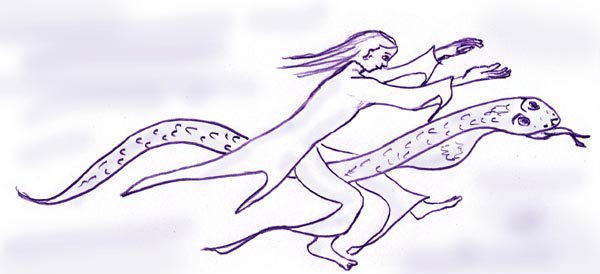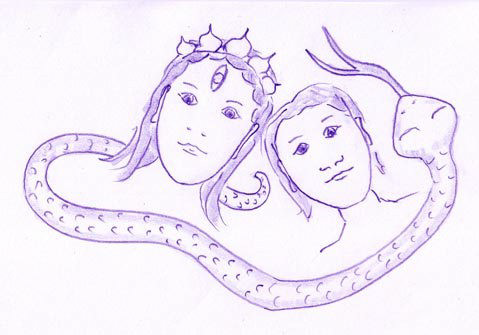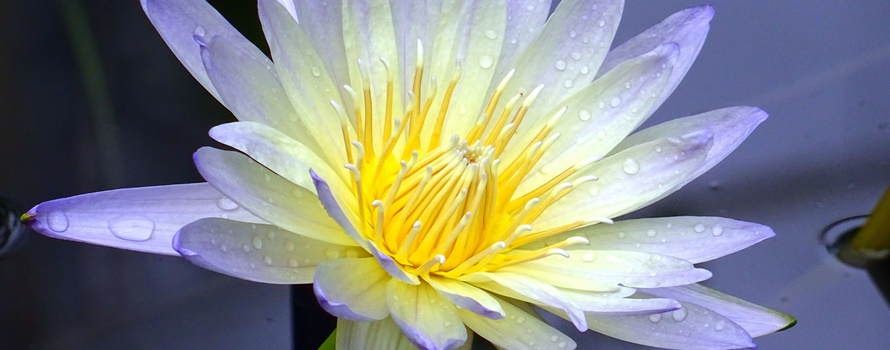Kundalini as Inner Teacher
Originally, many people believed that through various yoga exercises Kundalini is caused to rise up from chakra to chakra. Once it has reached the seventh chakra, it will just click and then the person is enlightened. It is not as easy as that, though (fortunately), because to develop and to reach for the multifaceted, great and all-pervasive cosmic consciousness also means to grow, to mature and learn inside. Kundalini is energy. It is not enlightenment, even not if we find ourselves surrounded by light. A perception of light may last seconds or minutes and this state may be called "enlightenment" – for this short period of time. But when looking at a whole life, one is nowhere near to being enlightened.

She teaches you how to fly and reveals to you the wonders of creation
With the help of the Kundalini we can open us and experience the life around us more directly and in a process of identification. The Kundalini teaches us to see the beauty, but our dark sides as well – and to accept them. It teaches, urges, forces us to correct them. It brings light into the twilight of our soul. In this light it is possible to come closer to the divine principle. With every step that we take, the divine cosmic consciousness comes three steps closer to us. If we are ready, we can also sense the proximity of the divine, even perceive it – as the goddess in appearance of our Shakti or as a male spiritual guide. Kundalini teaches in different ways.
Illness
First of all: Kundalini does not cause the physical or psychic disorders, but it reinforces them. It is a strong inner force which maybe can become manifest in placebo and nocebo effects or in other ways.
As long as someone is not able to listen inwards to perceive how the energies are flowing, where they are blocked and what makes them being blocked, Kundalini will teach in another way, through the body – the human becomes ill and remains ill until the inner wrong attitude is corrected. The illness becomes chronic and presumably this is due to a wrong attitude in way of life or in the psyche, which affects the body psychosomatically.
Illnesses caused by Kundalini are strange. Such illness is known from the Afrcian and Eurasian shamanism: the person is suffering from a physical disorder which no doctor can heal. As soon as they started to go the way of shamanism, which was "chosen by the ancestors", they were suddendly healed from their illness although they had suffered from it through years before. According to the shamanisti belief, these people were forced by the ancestors to go the way of shamans. If they became shamans, they were healed. If they refused, the illness got ever worse, sometimes until death. All these cultures believed in this and very often it proved to be true. Of course every one of them went to the doctor or healer first and tried everything. But the inner way restructured everything – life and the inner powers as well.
Effects through the psyche
Here everything applies which has been said about physical illness. Depressions are very common. But a reasonable person will always go to a doctor first and only when nothing helps he will search for alternatives.
Listening inwards
By listening inwards, one gets a feeling for the inner processes. From now on it is proceeding fastly, regardless of the person being practicing yoga or not – it’s all the same to the Kundalini. An inner harmony and balance is reached soon.
Inner communication
Here everything works fine. If something does not work, a question is asked inwards and at once, an answer comes back with a hint to what needs to be changed or how we should go on. However, who gives this inner answer isn’t clear in the most cases. The message comes from inside, but who or what gave this message cannot be recognized, at least not in everyday life. In a state of trance it is easier to assign the message, although doubts about the interpretation are alright and healthy, because in this way we stay open for new things and we will not get confined to narrow-minded thinking.

Shakti, yogi and Kundalini
© Alfred Ballabene (Vienna) translated by Corra

